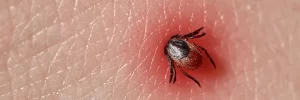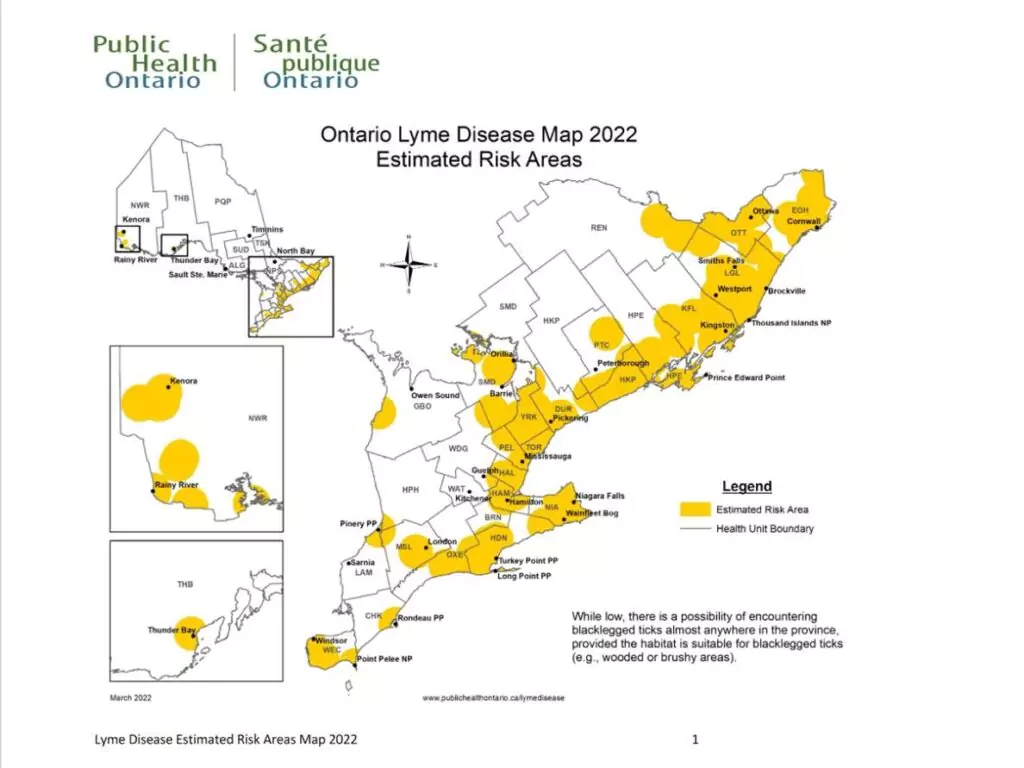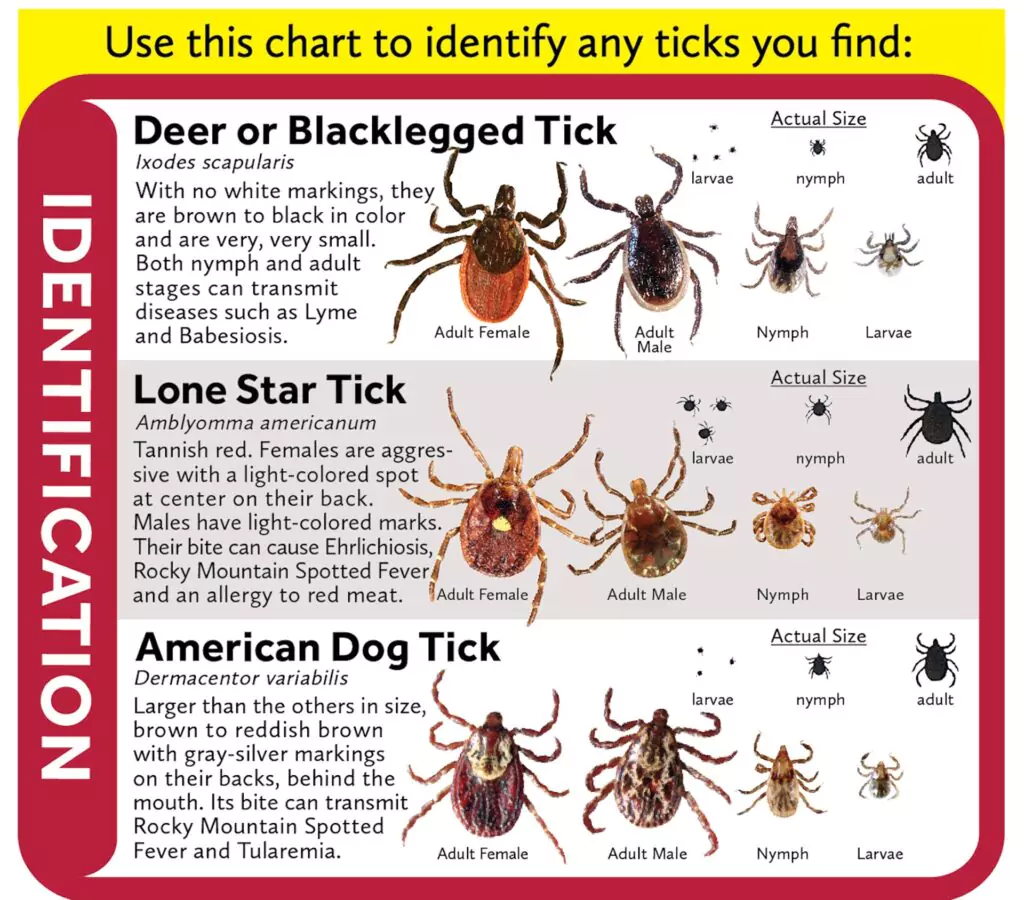It was only last summer when Dentec Safety Specialist’s VP Judy Dente participated in a Yoga Retreat one weekend in Lake Simcoe, only to come home to notice a black bump on the back of her leg.
“I just returned from a relaxing day in Lake Simcoe practicing yoga outdoors, when I noticed something small and dark on the back of my leg when I got out of the shower. To my horror, I realized it was a tick burrowed in my skin. I definitely panicked, but immediately knew not to touch it and get the Tick Removal Tool from our Tick Removal Kit out immediately (luckily we have always kept one stocked and at home).
I was able to quickly remove it completely without crushing or damaging the tick and get it into a container to have it submitted for examination. I was fortunate enough to have identified it early and received anti
–biotics quickly before any symptoms appeared. Fortunately, I did not contract Lyme disease or any other infections that are associated with tick bites. Looking back, I was sitting in grass near a wooded area all day, as well as had a dog cuddle close to me while lying on my yoga mat. I realize now it was a high risk setting for tick bites.”

TICKS THAT CARRY LYME DISEASE

The bite of an infected blacklegged tick can transmit Lyme disease, a potentially serious infection that’s symptoms include headache, fever, chills, muscle aches and joint pains, facial paralysis, swollen lymph nodes and fatigue. Symptoms of Lyme disease will usually appear between three and 30 days after infection. One of the first and most common symptoms to look out for is a bulls eye rash that often appears around or near the tick bite and spreads outwards and grows.
Is Lyme Disease Curable?
Lyme disease left untreated can lead to serious health issues and affect your heart, nerves, joints and liver and even lead to neurological problems, arthritis and in very rare cases death. If you are showing signs of Lyme Disease and/ or have been bitten by a tick, you should speak to your healthcare professional immediately. Fortunately, most cases of Lyme disease can be treated with antibiotics if identified early.
Source: Lyme disease | Public Health Ontario
TYPES OF TICKS
Several factors including human and environmental have led to a population increase of ticks throughout North America. According to infectious diseases specialist Dr. Isaac Bogoch:
“If you look at Canada, there’s a rise in Lyme disease year after year,” said Bogoch. “We are very likely seeing a greater range of the ticks that transmit Lyme, largely driven by climate change and expanding the range of ticks that are capable of transmitting this.”
Source: Toronto woman shares encounter with dozens of ticks in her suburban backyard | Globalnews.ca
Between the two families of ticks (hard ticks and soft ticks) there are a total of 900 species throughout the world but only few pose a threat of disease transmission to humans in North America.

MOST COMMON TYPES OF TICKS FOUND IN CANADA
American Dog Tick
The American god ticks have a dark brown body.
Females have an off-white shield, while adult males look more mottled. The greatest risk of being bitten is from the adult females during the spring and summer months.
Pathogens: A bacteria that causes Rocky Mountain spotted fever, Tularemia and tick paralysis.
Location: This tick has a broad distribution east of the Rocky Mountains, throughout the East and Gulf Coast, along the Pacific Coast, into Canada and parts of Alaska. American dog ticks are mostly found in areas with little or no tree cover, such as tall grassy fields and low– lying brush and twigs, as well as along walkways and trails.
Source: Types of Ticks (with pictures of ticks) | Lymedisease.org
Blacklegged “Deer” Tick
This tick is most easily identified by its reddish-orange body, black shield, and dark black legs.
Pathogens: The deer tick is known to transmit Borrelia burgdorferi (the agent of Lyme disease), Borrelia mayonii (which causes a Lyme-like illness), Borrelia miyamotoi and Borrelia hermsii (that both cause relapsing fever Borreliosis), Ehrlichia muris (ehrlichiosis), Anaplasma phagocytophilum (anaplasmosis), Babesia microti (babesiosis), multiple species of Rickettsia, deer tick virus, and Powassan virus. This tick is also suspected of transmitting Bartonella to humans.
Location: Over the last two decades, the distribution of blacklegged ticks has expanded. They are now found throughout the eastern U.S., large areas in the North and Central U.S., and the South. The northern distributions of the blacklegged tick are continuing to spread in all directions from two major endemic areas in the Northeast and Upper Midwest. It’s important to note that adult ticks will search for a host any time when temperatures are above freezing, including winter.
Blacklegged ticks are found in a wide variety of habitat that are suitable for birds, large and small mammals such as mice, deer, squirrel, coyotes and livestock. All life stages can bite humans, but nymphs and adult females are most found on people who are in contact with grass, brush, leaves, logs or pets that have been roaming the outdoors.
Source: Types of Ticks (with pictures of ticks) | Lymedisease.org
Lone Star Tick
This tick is reddish-brown in color. The adult female is distinguished by a white dot or “lone star” on her back.
Pathogens: The nymphal and adult ticks can transmit human monocytotropic ehrlichiosis (HME), Ehrlichiosis (Ehrlichia chaffeensis, Ehrlichia ewingii, and Panola Mountain ehrlichia), Rickettsiosis, Rocky Mountain spotted fever (RMSF), Tularemia, Heartland virus, Bourbon virus, Q fever and tick paralysis, as well as Borrelia lonestari, which causes Southern tick-associated rash illness “STARI,” an illness almost identical to Lyme.
Location: The lone star tick is widely distributed throughout the Eastern U.S. but is most prevalent in the South. These ticks are notoriously aggressive biters, with the greatest risk of being bitten from early Spring through late Fall.
Source: Types of Ticks (with pictures of ticks) | Lymedisease.org
For the full list of types of ticks and descriptions visit: Types of Ticks (with pictures of ticks) | Lymedisease.org

TICKS & TICK BITES: HOW TO REDUCE YOUR RISK

- Keep covered especially if you live, work in or are planning to spend time in a wooded area or an area with tall grass and/ or bushes. Wear light colours so you can easily see ticks, long sleeved shirts, pants, closed-toe shoes and even tuck your pants into your socks.
- Check yourself, others, and children when you come indoors. Use the buddy system and always have someone scan you for ticks or tick bites when you come in from a high-risk setting, especially children who often play and lay in grass. Look:
- Behind the knees
- On the head
- In the belly button
- In the groin area
- In your armpit
- On the back of the body
- Check your pets for ticks when they come indoors. Like Judy’s experience, Ticks can easily cling to animal fur and skin. Dogs and cats who spend time outdoors are at a higher risk of tick bites or bringing ticks into your home.
- Keep a Tick Removal Kit stocked, handy or near

- Use Insect Repellent like SkeetSafe that contains “DEET” and apply it to both exposed skin and your clothes.

- Put your clothes in the dryer. Stripping down and putting your clothes immediately into the dryer for 10 minutes on high heat after coming in from outdoors can kill any ticks that may be on them.
Source: Lyme disease | ontario.ca
HOW TO REMOVE A TICK

We recommend that whenever possible use a Tick Removal Tool VS tweezers. Tick Removal Tools like the ones provided in Dentec’s Tick Removal Kits
are designed specifically to remove ticks without crushing or damaging the tick as it can cause Lyme bacteria from the tick to be released into your bloodstream.
Step 1. Choose the most suitable hook according to the size of the tick.
Step 2. Engage the hook by approaching the tick from the side until it is held.
Step 3. Lift the hook very lightly and turn it. The tick detaches by itself after 2 or 3 rotations.
Your main aims are to remove the tick promptly, to remove all parts of the tick’s body and to prevent it releasing additional salvia or regurgitating its stomach contents into your bite wound.
DO start cleansing the tweezers/ tool with antiseptic. After tick removal, cleanse the bite and the tool with antiseptic.
DO wash hands thoroughly afterwards.
DO save the tick in a container in case a doctor asks for evidence that you have been bitten (label it with date and location).
DO NOT squeeze the body of the tick, as this may cause the head and body to separate, leaving the head embedded in your skin.
DO NOT use your fingernails to remove a tick. Infection can enter via any breaks in your skin, e.g close to your fingernail.
DO NOT crush the tick’s body, as this may cause it to regurgitate its infected stomach contents into the bite wound.
DO NOT try to burn the tick off, apply petroleum jelly, nail polish or any other chemical. Any of these methods can cause discomfort to the tick, resulting in regurgitation, or saliva release.
Tweezers
If you don’t have a Tick Removal Kit or Tick Removal Tool available, then use a pair of fine-tipped tweezers to grasp the tick as close to the skin’s surface as possible.
- Pull upward with steady, even pressure. Don’t twist or jerk the tick; this can cause the mouth
–parts to break off and remain in the skin. If this happens, remove the mouth–parts with tweezers. If you are unable to remove the mouth easily with clean tweezers, leave it alone and let the skin heal. - After removing the tick, thoroughly clean the bite area and your hands with rubbing alcohol, an iodine scrub, or soap and water.
Source: www.cdc.gov
For information about Tick Submission and Testing visit: Tick Submission and Testing FAQ (publichealthontario.ca)
Disposing of the tick: Be aware that engorged ticks will contain potentially infected blood, which may splatter when crushed. Do not crush the tick with your finger and do not allow the crushed tick or the blood it carried to contact your skin.
For information on Tick Kits or customizing a First Aid program for your business, contact one of our Safety Specialists or call us at 888-533-6832.
Dentec Safety is a leading manufacturer and distributor of safety products in the North America since 2004. Dentec Safety is dedicated to providing the highest quality safety products and solutions delivering enhanced value and comfort. Our expertise from decades of experience in Industrial Safety and our innovative design technologies have solidified us as thought leaders in the field. Protection and comfort are at the core of everything we do at Dentec. As a leading manufacturer of Safety Solutions, it is our mission to help organizations do the right thing, keep their employees safe and exceed Industry Health & Safety Standard.








